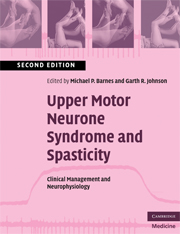Book contents
- Frontmatter
- Contents
- List of Contributors
- Preface to the second edition
- 1 An overview of the clinical management of spasticity
- 2 Neurophysiology of spasticity
- 3 The measurement of spasticity
- 4 Physiotherapy management of spasticity
- 5 Seating and positioning
- 6 Orthoses, splints and casts
- 7 Pharmacological management of spasticity
- 8 Chemical neurolysis in the management of muscle spasticity
- 9 Spasticity and botulinum toxin
- 10 Intrathecal baclofen for the control of spinal and supraspinal spasticity
- 11 Surgical management of spasticity
- 12 Management of spasticity in children
- Index
7 - Pharmacological management of spasticity
Published online by Cambridge University Press: 22 August 2009
- Frontmatter
- Contents
- List of Contributors
- Preface to the second edition
- 1 An overview of the clinical management of spasticity
- 2 Neurophysiology of spasticity
- 3 The measurement of spasticity
- 4 Physiotherapy management of spasticity
- 5 Seating and positioning
- 6 Orthoses, splints and casts
- 7 Pharmacological management of spasticity
- 8 Chemical neurolysis in the management of muscle spasticity
- 9 Spasticity and botulinum toxin
- 10 Intrathecal baclofen for the control of spinal and supraspinal spasticity
- 11 Surgical management of spasticity
- 12 Management of spasticity in children
- Index
Summary
Introduction
The management of spasticity requires a multiprofessional approach and is based on addressing the troublesome effects of the increased tone. Nursing staff have a considerable role in this context along with physiotherapists, occupational therapists, speech and language therapists and doctors. The essential treatment of spasticity is physical. Even when pharmacological agents are used, physical treatment strategies should be in place and pharmacological interventions should be regarded as adjunctive rather than as substitutes for physical management (Ward et al., 1997).
Spasticity may not be harmful, particularly in early rehabilitation after an injury to the brain or spinal cord, where it may be utilized to improve functioning. For example, a spastic leg with minimal motor control may be a useful prop after a stroke to allow a stand pivot transfer and weight bearing. Treatment should be clearly set within the context of goals for rehabilitation (Ward et al., 1997). Even in patients who develop this impairment without much disability, treatment goals should be documented and agreed on with the patient and carers. Spasticity is not a condition that needs treatment in its own right and, indeed, medication may sometimes result in systemic side effects producing greater impairment. There are several situations in which spasticity reduction would serve no valid functional goal. For example, a patient with severe spasticity and poor selective motor control but whose spasticity is not painful and not interfering with care or positioning may not experience any improvement after tone reduction.
Keywords
- Type
- Chapter
- Information
- Upper Motor Neurone Syndrome and SpasticityClinical Management and Neurophysiology, pp. 131 - 149Publisher: Cambridge University PressPrint publication year: 2008
- 1
- Cited by

